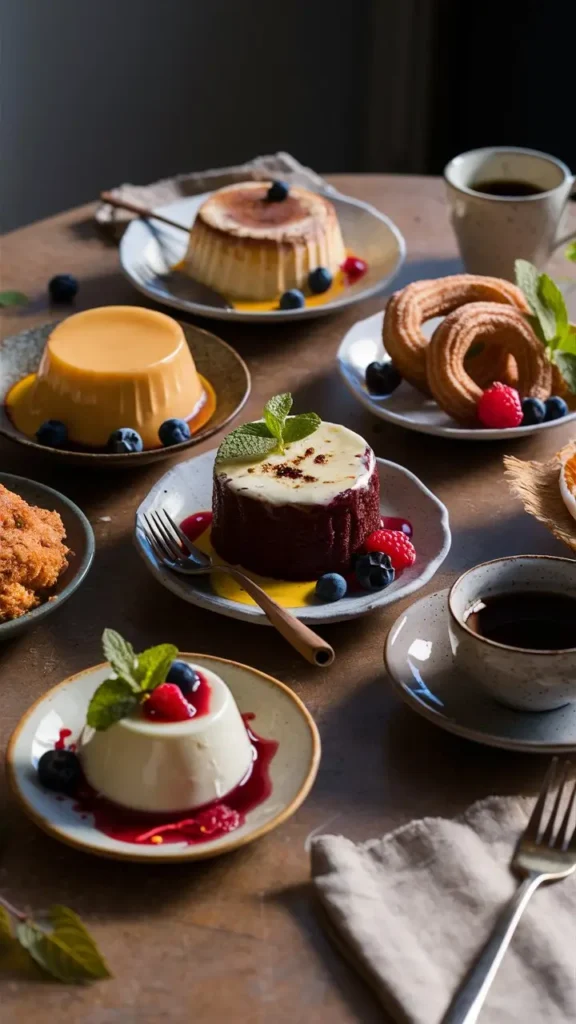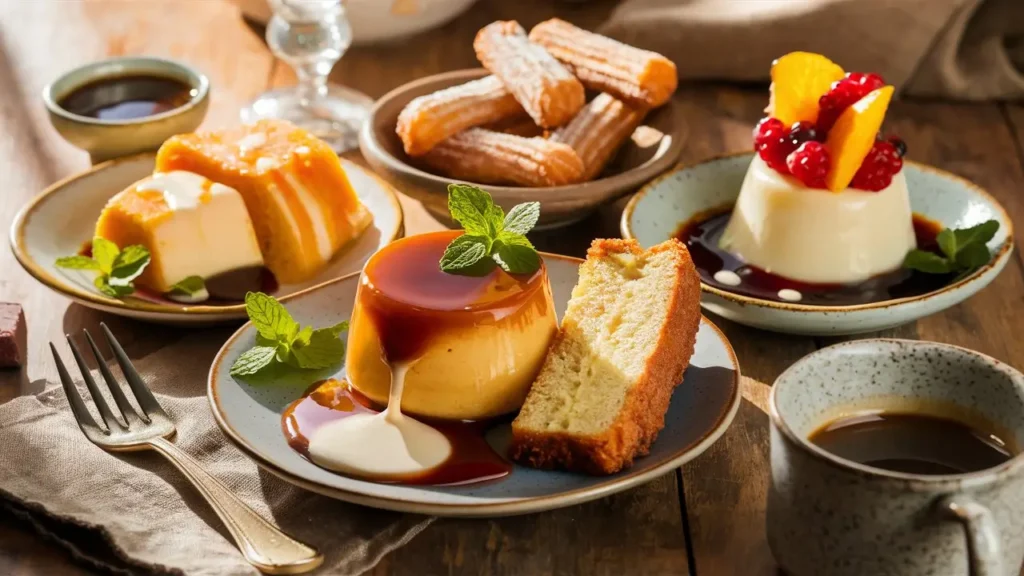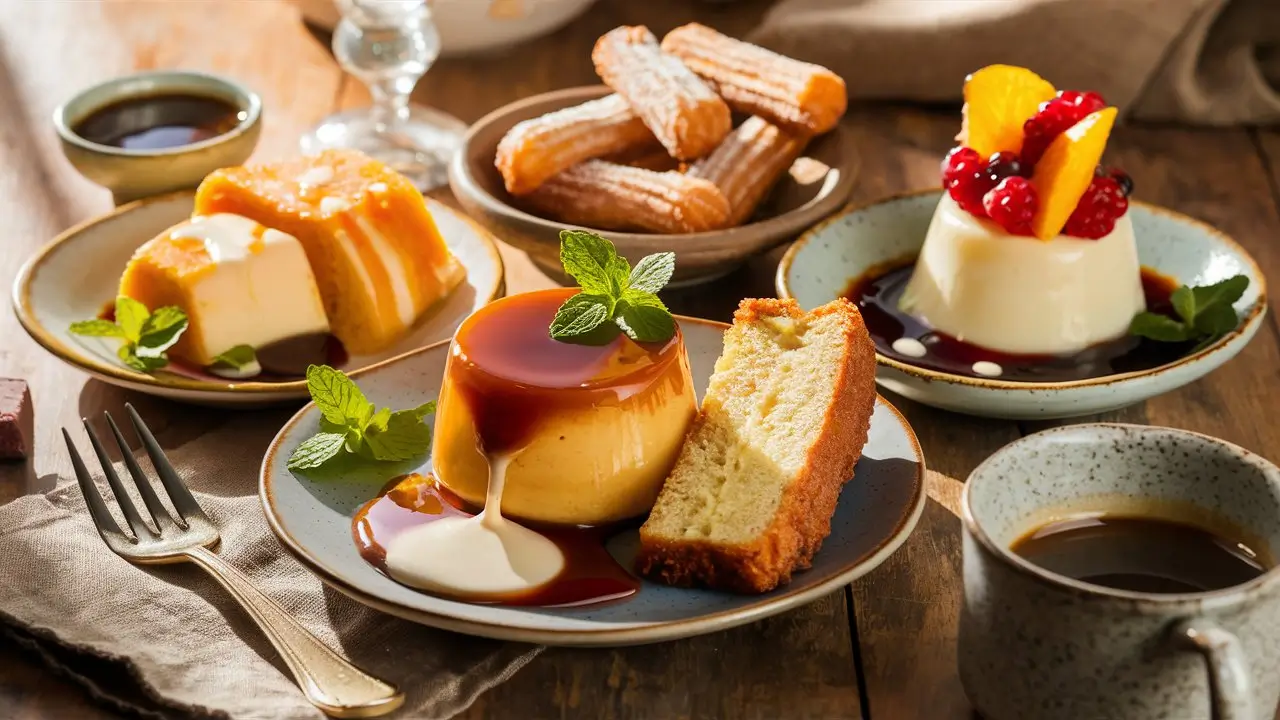If you have a sweet tooth and a passion for global flavors, postres—Spanish for desserts—are a delicious path to explore. From creamy custards and flaky pastries to fruity treats and fried delights, postres showcase the rich culinary traditions of Spain and Latin America.

Why You Will Love Exploring Postres
-
Rich Cultural Heritage – Postres blend indigenous, Spanish, and African influences.
-
Wide Variety – From flan to churros, there’s a dessert for every taste and texture.
-
Simple Ingredients – Most recipes use eggs, sugar, milk, and flour—things you already have.
-
Perfect for Any Occasion – Whether it’s a casual gathering or a holiday feast, postres always impress.
Common Ingredients Used in Postres
Understanding the essential ingredients can help you recreate authentic postres at home:
-
Eggs – Used in flans, cakes, and custards for richness and structure.
-
Milk or Cream – A base for many creamy desserts like arroz con leche and natillas.
-
Sugar – For sweetness and caramelization.
-
Vanilla and Cinnamon – Classic flavor enhancers.
-
Flour and Cornstarch – Used in cookies, cakes, and thickened creams.
-
Tropical Fruits – Mango, guava, banana, and coconut are common in Latin postres.
Ingredients List
-
1 cup sugar (for caramel)
-
4 large eggs
-
1 can (14 oz) sweetened condensed milk
-
1 can (12 oz) evaporated milk
-
1 tbsp vanilla extract
Timing & Servings
Each dessert varies, but here’s a general estimate for homemade postres:
-
Prep Time: 10–30 minutes (depending on the recipe)
-
Cook Time: 20–60 minutes
-
Total Time: 1–2 hours (some require chilling time)
-
Servings: 4–8 per recipe
How to Make Classic Flan at Home: A Step-by-Step Guide
Step 1- Melt sugar in a pan over medium heat to make caramel. Pour into a baking dish.
Step 2- Blend eggs, condensed milk, evaporated milk, and vanilla.
Step 3- Pour mixture over the caramel.
Step 4- Place in a water bath and bake at 325°F (160°C) for 50–60 minutes.
Step 5- Chill for a few hours, then unmold.

Tips for Making Perfect Postres Every Time
1. Be Precise
Desserts often rely on exact measurements and timing. Use a scale for accuracy when baking.
2. Don’t Rush the Cooling
Most postres—like flan and tres leches—taste better when chilled and rested.
3. Use Fresh Ingredients
Fresh eggs, whole milk, and real vanilla make a noticeable difference in flavor.
4. Balance Sweetness
Traditional postres can be very sweet. Adjust sugar to taste or pair with unsweetened beverages.
5. Practice Makes Perfect
Don’t worry if your first flan cracks or your churros aren’t straight. With time, your technique will improve.
Traditional Spanish Postres You Should Try
Flan (Caramel Custard)
Flan is one of the most iconic Spanish desserts. It’s a creamy baked custard with a caramel topping that melts in your mouth. The ingredients are simple: eggs, milk, sugar, and vanilla.
Pro Tip: Bake flan in a water bath to prevent it from curdling and ensure a silky texture.
Churros con Chocolate
Crispy on the outside and soft inside, churros are deep-fried dough sticks sprinkled with sugar and often dipped in thick hot chocolate. A favorite in Spain and Latin America.
Pro Tip: Use a star-shaped piping tip for authentic ridges and crispiness.
Crema Catalana
This dessert is often compared to crème brûlée. It’s a rich egg custard topped with a layer of caramelized sugar. The Spanish version often includes a hint of citrus or cinnamon.
Beloved Latin American Postres
Tres Leches Cake
A sponge cake soaked in three types of milk: evaporated milk, condensed milk, and heavy cream. This dessert is extremely moist and often topped with whipped cream and fruit.
Tip: Let the cake soak overnight for the best texture.
Arroz con Leche (Rice Pudding)
A comforting dessert made with rice, milk, cinnamon, and sugar. It’s creamy, slightly sweet, and often enjoyed warm or cold.
Dulce de Leche
This caramel-like sauce made by slowly cooking sweetened condensed milk is used in cakes, cookies, and as a topping. It’s popular across Argentina, Mexico, and Uruguay.
Cocadas (Coconut Macaroons)
Chewy, sweet, and rich in coconut flavor, cocadas are bite-sized treats that are easy to make and perfect for coconut lovers.
Famous Regional Postres by Country
Mexico: Buñuelos and Cajeta
-
Buñuelos are crispy fried pastries served with cinnamon sugar or piloncillo syrup.
-
Cajeta is goat milk caramel used in many Mexican sweets.
Argentina: Alfajores
These sandwich cookies are filled with dulce de leche and coated in powdered sugar or chocolate.
Peru: Mazamorra Morada
A thick purple corn pudding flavored with spices and fruits—served chilled and often paired with arroz con leche.
Cuba: Turrón de Coco
A coconut-based candy bar often enjoyed during holidays.
Colombia: Natilla and Buñuelos
A holiday favorite, natilla is a thick milk-based pudding often paired with fried buñuelos, cheese-flavored dough balls.
Postres for Special Occasions
Postres play a big role in celebrations across Spanish-speaking cultures.
-
Christmas: Natilla, buñuelos, turrón
-
Easter: Torrijas (Spanish-style French toast)
-
Day of the Dead: Pan de muerto with hot chocolate
-
Weddings: Tres leches or pastel de bodas
Healthy Alternatives to Traditional Postres
If you’re trying to cut back on sugar or dairy, you can still enjoy postres:
-
Use coconut milk instead of dairy in arroz con leche.
-
Replace sugar with natural sweeteners like honey or stevia.
-
Make baked apples or roasted plantains as a fruit-based dessert.
How to Pair Postres with Drinks
The right drink can elevate your dessert experience:
-
Espresso with churros
-
Sweet sherry or port with flan
-
Hot chocolate with pan dulce
-
Herbal teas with coconut desserts
FAQs
Q1: Can I make postres ahead of time?
Yes, many postres like flan, tres leches, and arroz con leche taste better the next day.
Q2: Are postres always sweet?
Most are sweet, but some can include savory elements like cheese in buñuelos or salt in caramel toppings.
Q3: Are there vegan versions of postres?
Yes. Use plant-based milk, egg substitutes, and coconut products to make vegan-friendly desserts.
Q4: What’s the difference between dulce de leche and caramel?
Caramel is made from sugar and water; dulce de leche is made from sweetened milk, giving it a creamier texture.
Q5: Do I need special tools to make postres?
Basic kitchen tools like a blender, baking dish, and whisk are usually enough. A piping bag is useful for churros.
Conclusion
Exploring postres is like taking a sweet journey through centuries of culture, family traditions, and shared celebrations. From Spain to Latin America, every dessert carries its own charm and comfort. As you try these recipes in your kitchen, you’re not just creating food—you’re keeping a delicious legacy alive. Whether you’re serving flan at a dinner party or enjoying arroz con leche on a cozy night, postres always bring joy to the table.
